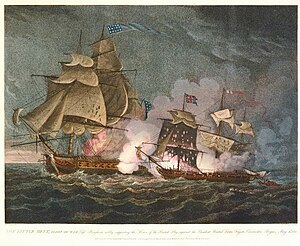| Revision as of 16:04, 6 July 2008 editSmackBot (talk | contribs)3,734,324 editsm Date the maintenance tags or general fixes← Previous edit | Revision as of 17:11, 12 August 2008 edit undo82.28.237.200 (talk) Indecisive conclusion - the Little Belt was not sunk, and it did not surrender. The US sailors also did not board the vessel or capture it.Next edit → | ||
| Line 6: | Line 6: | ||
| |date=], ] | |date=], ] | ||
| |place=off ] | |place=off ] | ||
| |result= |
|result=Indecisive | ||
| |combatant1={{flag|Great Britain}} | |combatant1={{flag|Great Britain}} | ||
| |combatant2={{flag|United States|1795}} | |combatant2={{flag|United States|1795}} | ||
Revision as of 17:11, 12 August 2008
| Little Belt Affair | |||||||
|---|---|---|---|---|---|---|---|
| Part of the events leading to the War of 1812 | |||||||
 An May 16, 1811 engraving shows USS President battling HMS Little Belt on May 16, 1811. | |||||||
| |||||||
| Belligerents | |||||||
|
|
| ||||||
| Commanders and leaders | |||||||
|
|
| ||||||
| Strength | |||||||
| 1 sloop-of-war | 1 frigate | ||||||
| Casualties and losses | |||||||
|
1 sloop damaged 10 killed 22 wounded | 1 wounded | ||||||
The Little Belt Affair was a naval battle on the night of May 16, 1811. It involved the American frigate USS President and the British sixth-rate HMS Little Belt, a sloop-of-war, which had originally been the Danish ship Lillebælt (Little Belt, after a location in Denmark), before being captured by the British in the 1807 Battle of Copenhagen. The incident took place off the North Carolina coast. The Little Belt Affair was one of many incidents and events that led to the War of 1812.
Background
The American attack was motivated in part as an act of vengeance for the Chesapeake-Leopard Affair in 1807, in which HMS Leopard had attacked USS Chesapeake, killing three, wounding 18, and capturing four men to serve on the Leopard as per the terms of impressment. Furthermore, President had been patrolling the American coast after an incident involving HMS Guerriere, a frigate. On May 1 the Guerriere had stopped the brig USS Spitfire off Sandy Hook in New Jersey. It had impressed Maine citizen John Diggio, the master apprentice of the Spitfire. The Secretary of the Navy, Paul Hamilton, ordered the President, along with USS Argus, to patrol the coastal areas from the Carolinas to New York.
The commanding officer of the President, Commodore John Rodgers, caught sight of Little Belt at approximately noon, believing it to be the Guerriere; he had the President pursue it. However, Little Belt had seen President around an hour before Rodgers's order. Little Belt's captain was Arthur Bingham. When Bingham had Little Belt ask President for identification and received none, he noticed a blue pennant designating the ship's nationality. He continued on his way past Cape Hatteras, but President continued its pursuit because Commodore Rodgers was interested in identifying the ship that he now knew was not Guerriere. By 15:30, the President was close enough to Little Belt for Rodgers to make out part of her stern. However, the angle at which Rodgers was seeing Little Belt made her appear larger than she actually was. In truth, Little Belt was much weaker than President, weighing only 460 tons compared to President's 1,576; the smaller ship had 20 guns, whilst President had 58.
Attack
By 18:30, fearing an attack and the improbability of getting away before nightfall (around 19:10), Bingham decided to identify his ship. At the time, this action was calling "hoisting colors". According to Rodgers, Bingham did so at 19:15, but it was too dark to correctly identify the British flag. Little Belt came about, and the leaders of the two ships each called out the standard hailing, "What ship is that?" Neither answered, each believing that he had hailed first and therefore deserved a reply first, so Bingham and Rodgers both hailed again.
The story is divided at this point. According to the Americans, Little Belt fired a cannon whose ball hit the President's mast. President also fired a cannon at Little Belt, apparently without the orders of Rodgers, who was hesitant to respond. A sloppy broadside erupted from Little Belt. Now offended, Rodgers gave the order to fire, and the battle commenced for, as Rodgers believed, 15 minutes at most. Rodgers claimed that he hailed Little Belt once more and learned of its presence in the Royal Navy.
Bingham's account varies in a number of ways. He claimed that President shot a complete broadside (not a single shot) at his ship after Rodgers's second hail. Bingham said that he responded with cannon fire, and the battle commenced for about 45 minutes, three times longer than Rodgers's estimate.
Results
President sustained only one human injury; Little Belt took ten deaths and 22 injuries, and the sloop was badly damaged in the attack. On the morning of May 17, American Lieutenant John Creighton went to Little Belt to apologize for the "unfortunate affair" and to offer space at any of the "Ports of the United States", which Bingham declined. When the captain asked why President had attacked his much smaller ship, Creighton claimed that it was because Little Belt had provoked the action. Bingham staunchly denied the account.
Creighton returned to his ship, and President and Little Belt parted ways. President sailed to New York City, and Little Belt went to Halifax, Nova Scotia. The two nations continued to argue about how the battle began for several months.
See also
References
| This article does not cite any sources. Please help improve this article by adding citations to reliable sources. Unsourced material may be challenged and removed. Find sources: "Little Belt affair" – news · newspapers · books · scholar · JSTOR (July 2008) (Learn how and when to remove this message) |